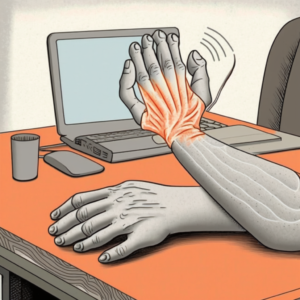Carpal Tunnel Syndrome is a condition that affects millions of people worldwide. It is caused by the compression of the median nerve as it passes through the carpal tunnel, a narrow passageway in the wrist. Symptoms may include pain, numbness, and tingling in the hand and fingers. If you suspect that you may have Carpal Tunnel Syndrome, there are a few simple tests that you can perform to help diagnose the condition. In this article, we will discuss those tests and provide information on what you should do if you test positive for Carpal Tunnel Syndrome.
1. Tinel’s Sign Test
Tinel’s Sign Test is one of the most common tests used to diagnose Carpal Tunnel Syndrome. To perform this test, tap the area over the median nerve on the palm side of your wrist using your index finger. If you experience tingling, numbness, or a shocking sensation in your fingers, it could be a sign that you have Carpal Tunnel Syndrome.
2. Phalen’s Test
The Phalen’s Test is another test commonly used to diagnose Carpal Tunnel Syndrome. To perform this test, you need to flex your wrist by pressing the backs of your hands together and allowing your fingers to hang down. Hold this position for 60 seconds. If you experience tingling, numbness, or pain in your fingers or hands, it could be a sign of Carpal Tunnel Syndrome.
3. Median Nerve Compression Test
The Median Nerve Compression Test is a test that can be done at home. To perform this test, hold your arm out in front of you with your palm facing down. Then, press the tips of your fingers together and try to lift your wrist. If you experience tingling, numbness, or pain in your fingers or hands, it could be a sign of Carpal Tunnel Syndrome.
4. Hand Grip Strength Test
The Hand Grip Strength Test is a test that measures the strength of your hand grip. To perform this test, squeeze a hand dynamometer as hard as you can using your affected hand. If your grip strength is weaker than normal, it could be a sign of Carpal Tunnel Syndrome.
If you have tested positive for Carpal Tunnel Syndrome, there are several treatment options available. The most commonly used treatments include physical therapy, occupational therapy, splinting, and surgery. Your doctor will work with you to create a treatment plan that best suits your needs.
In addition to treatment, there are several things that you can do to prevent Carpal Tunnel Syndrome from getting worse. These include taking frequent breaks, stretching your hands and wrists, maintaining proper posture, and avoiding repetitive motions that can exacerbate the condition.
In conclusion, Carpal Tunnel Syndrome is a common condition that can be diagnosed using a few simple tests. If you experience any of the symptoms mentioned above, it is important to seek medical attention as soon as possible. With proper treatment and preventative measures, you can relieve symptoms and prevent the condition from getting worse.
